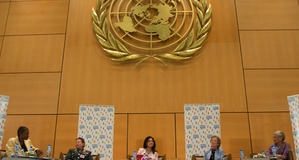Featured Article:Title IX and the Gender Binary: Trajectories of Equality
By
2014, Vol. 6 No. 04 | pg. 2/2 | « Notably, the Equal Protection Clause of the United States Constitution and Title IX’s prohibitions against sex discrimination have both been interpreted to encompass discrimination based on gender stereotypes and gender identity/expression; thus, schools may face legal liability if they deny access to transgendered athletes, even if there is no explicit treatment of the issue in the wording of the laws.64 Further, though injunctive relief to prevent future discrimination was the only relief available under Title IX prior to the Franklin v Gwinnet County Public Schools ruling in 1992, after the decision, monetary damages are also available.65 Therefore, equality litigation on the part of transgender athletes (especially those who face the stricter participation restrictions) is potentially a costly problem for Title IX schools. Currently, athletic programs are one of the educational activities under Title IX that can be separated based on the sex of students – however, this has been a litigious area of Title IX’s history.66 Future solutions may see gendered athletic participation recede. Postmodern feminists, for example, advocate for a seismic sport reform, namely, to entirely eliminate sex as an organizational category67, “…just as racial segregation in sport has been abolished on the basis of the revelation that race is not meaningful as a biological category, so too should sex segregation…sport should be radically restructured to eliminate sex identity as a basis for organizing, separating or grouping individuals…”68 Eliminating sex status would end contested gender assignments: “There would be no need, for example, for an International Olympic Committee policy for transsexual participation or for transgender persons to produce official documents attesting to their sex category assignment.”69 Eliminating discrimination, though, might not be so simple as removing gender categories altogether. For example, men and women have physical differences that affect their ability to participate in elite athletics: boys add muscle and increase flexibility more easily due to greater testosterone levels, and girls add fat rather than muscle due to increasing levels of estrogen,70 meaning that they must train rigorously to get significantly stronger.71 Girls are more likely to suffer chronic knee pain, shin splints, and stress fractures.72 Girls are also vulnerable to concussions: women who play soccer suffer concussions as frequently as male football players.73Physical transitions, unfortunately, are seen to pose parity issues: some sports fans are against the inclusion of transgender athletes because they think transsexual athletes skew outcomes. This issue has been explosive in the world of Mixed Martial Arts (MMA), with the outing of Fallon Fox, who competed successfully as a woman for years. The discovery that the successful fighter was male at birth raised, for some critics, the issue that women could potentially lose out on scholarships made available by Title IX: “What is to prevent a male athlete who was passed over by the recruiters to pursue collegiate competition via an operation he is not required to disclose?”74 Because of these attitudes and issues, transgender and transsexual athletes are subject to a high degree of scrutiny: The predominant assumption of male athletic superiority that characterizes this ‘unfair advantage discourse’…in sporting policy has a powerful hold on western consciousness. In spite of evidence that human variation is inconsistent with a two sex system…and failedattempts by the International Olympic Committee’s medical commission to develop a definitive test for female athletes…gender deviant athletes must achieve dimorphic physical and hormonal conformity or face exclusion.75 Whatever the proposed solution, we must face the realities of biological differences without becoming obsessed with drawing bright lines that may not exist; new competition categories must be construed carefully if gender is phased out as the main criteria. An Uncertain Future: A New EqualityThough the impetus for Title IX was gender equality, the reality is that the resulting social effects are far from the goal. Men, women, and transsexual athletes are all suffering in some form under the current Title IX scheme. Maybe, then, equality in sports should not be divided under “gender” lines at all, because gender is a construct, and leads to unhealthy attitudes towards athletes. Dismantling a binary view of gender in sport involves complications, though, and future discussions about a new athletic paradigm will be needed in order to ensure equality for all. ReferencesAnn Travers, “The Sport Nexus and Gender Injustice” (2008) 2 Studies in Social Justice 79. Carrie Lukas, “Title IX a Losing Game for Men,” National Review Online (30 March 2007) online: CBS News. Carrie Lukas, “Title IX’s Dark Legacy,” US News (22 June 2012) online: US News. Diane Heckman, “Scoreboard: A Concise Chronological Twenty-Five Year History of Title IX Involving Interscholastic and Intercollegiate Athletics” (1997) 7 Seton Hall J Sport L 391 (HeinOnline). Donna A Lopiano, “Modern History of Women in Sports: Twenty-five Years of Title IX” (2000) 19 Clinics in Sports Medicine 163, (ScienceDirect). Emily Liang, “The Media’s Sexualization of Female Athletes: A Bad Call for the Modern Game” (2011). Student Pulse 3 (10). “History of Title IX,” online: TitleIX.info. Honorable Donald E Shelton, “Equally Bad is Not Good: Allowing Title IX ‘compliance’ by the elimination of men’s collegiate sports” (2001) 34 U Mich JL Reform 253 (HeinOnline). John Pudner, “Transgender Athletes Could Take Title IX Scholarships” (27 March 2013), online: BreitBart. Kye Allums, “How I’ve Turned My Struggle as the NCAA’s First Transgender Athlete Into Acceptance” Playboy (9 October 2013) online: Playboy. Marcus Christenson & Paul Kelso, “Soccer chief’s plan to boost women’s game? Hotpants” The Guardian (16 January 2004), online: The Guardian. Michael Sokolove, “The Uneven Playing Field” The New York Times Magazine (11 May 2008), online: The New York Times Magazine. National Collegiate Athletic Association, Media Release, “Transgender Policy Approved” (13 September 2011) online: NCAA. “Participation of Transgender Athletes: The Foundation Position,” online: Women’s Sports Foundation. Pat Griffin, “Inclusion of Transgender Athletes on Sports Teams,” online: transgenderlaw.org. Peter Keating, “The Silent Enemy of Men’s Sports,” ESPNW (23 May 2012) online: ESPNW Today. tasser10, “Title IX and UCLA,” Bruins Nation (12 May 2011), online: SB Nation. “Title IX Legislative Chronology,” online: Women’s Sports Foundation. The CNN Wire Staff, “First transgender athletes to play in NCAA basketball” CNN US (4 November 2010) online: CNN US (article and video). Endnotes1.) Lopiano, at 163. 2.) Lopiano, at 163. 3.) Lopiano, at 163. 4.) “Title IX Legislative Chronology” 5.) “History of Title IX” 6.) “History of Title IX” 7.) “History of Title IX” 8.) “Title IX Legislative Chronology” 9.) “History of Title IX” 10.) “Title IX Legislative Chronology” 11.) “Title IX Legislative Chronology” 12.) “Title IX Legislative Chronology” 13.) “Title IX Legislative Chronology” 14.) “Title IX Legislative Chronology” 15.) Lopiano, at 164. 16.) Lopiano, at 164. 17.) Lopiano, at 165. 18.) Lopiano, at 165. 19.) Lopiano, at 164. 20.) Lopiano, at 164. 21.) Lopiano, at 164. 22.) Lopiano, at 164. 23.) tasser10. 24.) Lukas, “Title IX a Losing Game for Men.” 25.) tasser10. 26.) Shelton, at 255. 27.) Shelton, at 255-256. 28.) Keating. 29.) Lukas, “Title IX a Losing Game for Men.” 30.) Lukas, “Title IX’s Dark Legacy.” 31.) Lukas, “Title IX a Losing Game for Men.” 32.) Keating. 33.) Shelton, at 256. 34.) Shelton, at 256. 35.) Travers, at 83-84. 36.) Travers, at 83-84. 37.) Christenson & Kelso. 38.) Christenson & Kelso. 39.) Christenson & Kelso. 40.) Liang. 41.) Liang. 42.) Travers, at 83. 43.) Liang. 44.) Liang. 45.) Liang. 46.) Liang. 47.) Heckman, at 391. 48.) Travers, at 80. 49.) Travers, at 80. 50.) Travers, at 80. 51.) Travers, at 80. 52.) Travers, at 80. 53.) Travers, at 80-81. 54.) Travers, at 80-81. 55.) Travers, at 82. 56.) Travers, at 80-81. 57.) The CNN Wire Staff. 58.) Allums. 59.) Travers, at 83. 60.) Griffin. 61.) National Collegiate Athletic Association. 62.) National Collegiate Athletic Association. 63.) National Collegiate Athletic Association. 64.) “Participation of Transgender Athletes: The Foundation Position.” 65.) “Title IX Legislative Chronology” 66.) Heckman, at 398. 67.) Travers, at 86. 68.) Travers, at 90-91. 69.) Travers, at 92. 70.) Sokolove. 71.) Sokolove. 72.) Sokolove. 73.) Sokolove. 74.) Pudner. 75.) Travers, at 83. Suggested Reading from Inquiries Journal
Inquiries Journal provides undergraduate and graduate students around the world a platform for the wide dissemination of academic work over a range of core disciplines. Representing the work of students from hundreds of institutions around the globe, Inquiries Journal's large database of academic articles is completely free. Learn more | Blog | Submit Latest in Law & Justice |


















